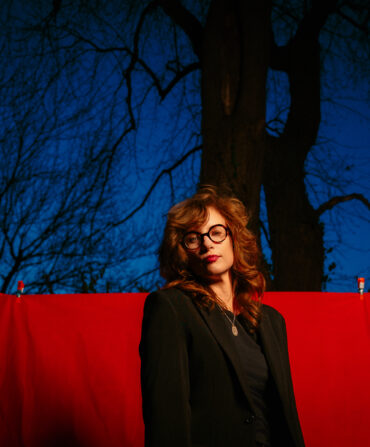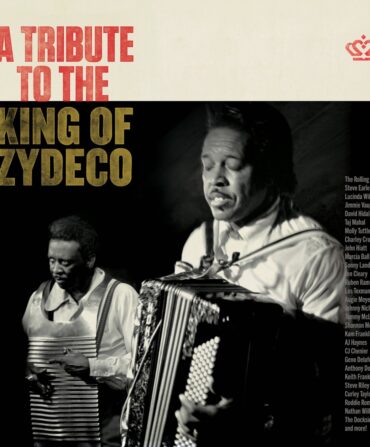Alison Krauss opens the door to her modest Nashville bungalow with her white iPhone sandwiched between her shoulder and ear. She’s wearing faded blue jeans, a navy-and-red patterned knee-length jacket, and some fabulous maroon velvet wedge sneakers with four straps. She ushers me in with a quick smile before disappearing into the kitchen to finish her call. It’s a frigid day with snow in the forecast, complicating her plan to drive to Birmingham to sing backup at a show by the outlaw country star and her good friend Jamey Johnson. The heat is running full blast in the house Krauss has lived in for almost fifteen years, a cozy space with worn hardwood floors and soft earth tones on the walls.
Several paintings hang in the living room, including a large landscape of trees and pieces by her grandmother, who worked as an artist for the Marshall Field’s department store in Chicago. Her mother painted as well, but Krauss didn’t inherit that particular gene. “I’m a watcher, not a painter,” she quips. What you won’t find displayed, however, are any of the forty-five-year-old’s twenty-seven Grammys, the most by any female artist and tied with Quincy Jones for the second most of all time. In the 1990s, her work with her band Union Station and her solo efforts, as well as her contributions to the 2000 sound track of the Coen brothers’ film O Brother, Where Art Thou?, helped bluegrass reach startling new heights. The sound track would go on to sell more than eight million copies and win a Grammy for Album of the Year.
Such celebrity can be overwhelming, and Krauss has remained steadfast in her desire to keep her work outside of the home. There doesn’t seem to be a hint of shine or ego. “My mother says the reward for hard work is hard work,” she says, matter-of-factly. “And that’s the truth. It’s satisfying to finish something and feel like it’s the best you can do.”
There’s room on the couch, but Krauss sits on an ottoman, almost squatting, her elbows on her knees, with her high-school-age son Sam’s guitar in front of her. Sam is going through a Def Leppard phase, which is perhaps not surprising given Krauss’s long-professed love of heavy metal, especially AC/DC. “My brother and I would turn the amps on so loud,” she says. “And then we’d get a long cord and take the guitars outside and stand in the yard.”
For Krauss, inspiration can come from all quarters, whether she’s listening to the buzzing guitar of AC/DC’s Angus Young or staring at one of her mother’s paintings. “When I get drawn to a song, it’s the pictures I see,” she says. “The story itself comes alive, and you don’t even make it up yourself. It’s a fascinating process.”

Photo: David McClister
Alison Krauss, photographed at Riverwood Mansion in Nashville. Dress by Marissa Webb. Jewelry by Monica Rich Kosann. Shoes by Stuart Weitzman.
Pictures, in fact, played a role in the development of Krauss’s latest, Windy City, her first new release since 2011’s Paper Airplane and her first solo album since 1999, one that had been gestating as Krauss struggled with migraines as well as episodic bouts of dysphonia, a condition in which the throat tightens up. “Not a great condition for a singer,” she laments. But during a stay in London several years ago, she happened upon a photo book by the fashion photographer Bob Richardson. The pictures of models were taken in the 1960s, and while there was certainly beauty to them, Krauss was entranced by their mood and the feeling she got from the subjects. She kept thinking about the images, and finally became inspired to begin the process of making another album, drawn toward classic country and bluegrass songs with as much atmosphere as melody. “It sounds more cosmic than it is,” she says. “Some people like to watch a movie fifty times because of the feeling it gives them. I’m kind of that way with photos.”
For help in selecting just the right tracks, she enlisted Buddy Cannon, a renowned Nashville producer who has worked with some of the biggest names in country, from Kenny Chesney to Willie Nelson. Krauss and Cannon would sit in his office sifting through potential songs, and she eventually put the original versions on a CD she would listen to while driving around town. As they made their selections, it became apparent that there was a thread running through each track, one of tremendous loss and heartbreak but also strength, a resilience against falling into despair. “It wasn’t conscious at the time,” she says. “You find things that you like, that you’re drawn to, and then at the end you’re like, ‘Oh, here’s a theme.’”
“All Alone Am I,” originally popularized by Brenda Lee, is as close to a torch song as Krauss has ever done, accompanied by a mournful piano, steel guitar, and sweeping strings. Her version of Willie Nelson’s “I Never Cared for You” trades Nelson’s stark sound for something more lush, with Krauss’s honeyed soprano backed by Suzanne and Sidney Cox of the gospel-steeped Cox Family band, whom Krauss considers to be her closest friends. “She has an amazing talent for finding great songs,” says Suzanne. “It’s a real gift. She kept the theme to herself, but she knew what she wanted. And I’ve always wanted her to make a whole album of country songs.”
But the two highlights—“Windy City” and “It’s Goodbye and So Long to You”—were both recorded by the Osborne Brothers, a 1960s and 1970s bluegrass group and one of the genre’s most adventurous duos. “They’re slick, magical, and high, but mysterious,” Krauss says. “And there’s a certain joy to it that, let’s say, the Stanley Brothers don’t have.”
The album’s title track spins the tale of two lovers who trade their innocence for the temptations of living in the city, while “It’s Goodbye and So Long to You” becomes a joyous Mardi Gras–style romp of blaring horns and rollicking piano, with backup vocals from none other than Hank Williams, Jr. Krauss had never met him before recording the track, but his distinct low-end rumble was exactly what she was looking for. “You really hear his personality,” she says. “It’s a beautiful contrast.” Williams’s voice was also a nostalgic touchstone for Krauss, reminding her of singers she would hear while wandering around the Champaign County Fair when she was growing up in Illinois. “There’s something about Hank and those trumpets,” she says. “It just reminded me of that time.”
Outside, the daylight is rapidly fading and some stray snowflakes begin to do a loopy dance in the wind. Krauss is unsure about plans to play any live shows with the Windy City material but divulges that she has a batch of new songs she keeps in a blue folder on her desk across the room from where she sits. They’ll most likely be for a new Union Station record, but she’ll know it when she feels it. “It’s a recognizable moment,” she says, “when you know that you’ve found the thing that you’re going to do next as far as work goes. I call it work. Whatever anybody wants to call it, I call it work. You have to chase it.”








